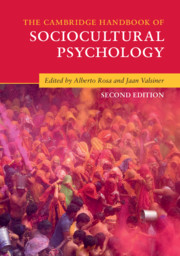Book contents
- The Cambridge Handbook of Sociocultural Psychology
- The Cambridge Handbook of Sociocultural Psychology
- Copyright page
- Contents
- Figures
- Tables
- Contributors
- Editors’ Introduction
- Part I Theoretical and Methodological Issues
- Part II Action, Objects, Artifacts, and Meaning
- Part III The Agent Rises a Reflective Self: Education and Development
- 11 Early Infancy – a Moving World: Embodied Experience and the Emergence of Thinking
- 12 Object Pragmatics: Culture and Communication – the Bases for Early Cognitive Development
- 13 Distinguishing Two Processes of Self-reflection
- 14 Making Memory: Meaning in Development of the Autobiographical Self
- 15 Mapping Dialogic Pedagogy: Instrumental and Non-instrumental Education
- 16 Development and Education as Crossing Sociocultural Boundaries
- Part IV Institutional Artifacts for Value
- Part V Aesthetic and Religious Experiences
- Part VI Practices and Artifacts for Imagining Identity
- Part VII Experiences Make the Person
- General Conclusion
- Index
- References
14 - Making Memory: Meaning in Development of the Autobiographical Self
from Part III - The Agent Rises a Reflective Self: Education and Development
Published online by Cambridge University Press: 25 June 2018
- The Cambridge Handbook of Sociocultural Psychology
- The Cambridge Handbook of Sociocultural Psychology
- Copyright page
- Contents
- Figures
- Tables
- Contributors
- Editors’ Introduction
- Part I Theoretical and Methodological Issues
- Part II Action, Objects, Artifacts, and Meaning
- Part III The Agent Rises a Reflective Self: Education and Development
- 11 Early Infancy – a Moving World: Embodied Experience and the Emergence of Thinking
- 12 Object Pragmatics: Culture and Communication – the Bases for Early Cognitive Development
- 13 Distinguishing Two Processes of Self-reflection
- 14 Making Memory: Meaning in Development of the Autobiographical Self
- 15 Mapping Dialogic Pedagogy: Instrumental and Non-instrumental Education
- 16 Development and Education as Crossing Sociocultural Boundaries
- Part IV Institutional Artifacts for Value
- Part V Aesthetic and Religious Experiences
- Part VI Practices and Artifacts for Imagining Identity
- Part VII Experiences Make the Person
- General Conclusion
- Index
- References
- Type
- Chapter
- Information
- The Cambridge Handbook of Sociocultural Psychology , pp. 260 - 273Publisher: Cambridge University PressPrint publication year: 2018
References
References
Further Reading
- 1
- Cited by

